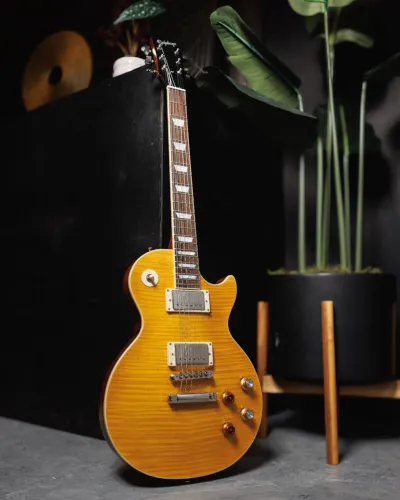Metallica’s Kirk Hammett shares about his special passion for the guitar: ‘The way I play has changed thanks to this guitar’

Kirk Hammett like discussing guitars a lot. So much so that when we brought up the subject, he didn’t even bring up a specific 58-times-platinum band he plays for until the very end of a 30-minute conversation with American Songwriter. The legendary member of Metallica spoke extensively about a guitar he adored and called Greeny, as well as his collaboration with the Gibson team to re-create that instrument for the general public.
In regard to a 1959 Les Paul Standard that was once owned by Fleetwood Mac’s Peter Green (hence the moniker), Hammett remarks, “It’s interesting because people sаy a lot of things have changed about me since I got that guitar.” “I have altered in all aspects of my playing—playing style, tone, attitude, and approach. Because of this instrument, over the last five or six years, all those things have altered. I’m overjoyed about it.

“Greeny helps me to connect to something inside of me or something from someplace else whenever I have to work on music, write, or respond to a musical inquiry. Nine times out of ten, I can get heavenly inspiration from Greeny. I control and play with it like a spout or pipeline to gain creative energy. Thank you very much for it.
It makes sense that Hammett would be so devoted to this instrument. He and Metallica had just finished the 2023 leg of their tour in celebration of their highly acclaimed most recent album, 72 Seasons, when he chatted with us. (They’ll resume their travels in ’24.) Furthermore, Hammett’s first solo EP, Portals (2022), showcased his exceptional performance, songwriting, arranging, and production abilities.
There was no one instrument that could take full credit for the quality of work that Hammett produced on these projects. However, it says something that he has dipped into the well with Gibson on many occasions to produce various Greeny models, the most recent of which being an Epiphone model that lowers the price point to a level that is affordable for everybody.

“In the end, I want to inspire people,” says Hammett. “I want to encourage others to compose outstanding music.” In the future, I want to be able to enjoy excellent music. I want to take action to make sure that in the future, high-quality music is played. Since others have helped me in this way. It means so lot to me, so I simply want to keep it continuing. Inspiration has a tremendous power, and Greeny is a constant source of inspiration. It seems reasonable to spread the word about it worldwide.
The Course of “Greeny”
As previously noted, Peter Green’s performance of the guitar that rocked Hammett’s world during Fleetwood Mac’s blues-rock era initially made it famous. However, a separate source introduced it to an adolescent Hammett.

“I remember going to the Thin Lizzy section of a record store in Berkeley when I was about 16 years old,” Hammett says. “I took out a solo CD by Gary Moore, the sometimes featured lead guitarist for Thin Lizzy. A live image of Moore performing on stage with his back bowed and him bending a Les Paul note was featured on the back cover. I recall thinking, “What a cool Les Paul,” as I gazed at the photo. I also recall asking myself, “Why don’t many of the Les Pauls I see at Guitar Center look like that?” That was an odd thing. I was obviously gazing at Greeny.
Moore kept the instrument until the middle of the 2000s, when he made the decision to sell it to pay off some debt. Not long thereafter, Hammett, an enthusiastic collector of antique guitars, learned that it was for sale. However, he never thought the listed costs were reasonable; they were usually much higher.
In 2014, when visiting London and experiencing boredom, Hammett called his buddy and guitar vendor Richard Henry. As luck would have it, Greeny was one of the guitars Henry had to sell, and he was asking a lot less for it. From then, Hammett takes up the narrative.
He states, “I had never played Greeny.” “I have to admit, man—within 90 seconds of holding Greeny, I thought, ‘Oh my God, what’s going on here?'” It was satisfying. It sounded amazing. The trucks had amazing sounds. The cherry on top, however, was that the sound was so distinctive that it suԀԀenly fell out of phase when I turned the switch to the middle position. It was unlike anything I had ever heard.
He goes on, “That’s one of the cute things about Greeny.” It has a wonderful tone, and when it gets out of phase, the sound is really distinctive. It bears a signature. “I’m not giving you back this guitar,” I said Richard. Now it’s my guitar. Greeny and I came to an agreement, and I’ve had him ever since. I’m never that far away from Greeny. Everywhere I go, she’s either in the same room or the same building.